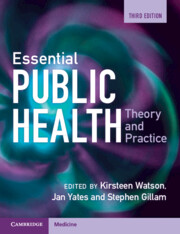41 results
Contributors
-
- Book:
- Essential Public Health
- Published online:
- 01 December 2023
- Print publication:
- 14 December 2023, pp vii-viii
-
- Chapter
- Export citation
3 - Epidemiology
- from Part 1 - The Public Health Toolkit
-
-
- Book:
- Essential Public Health
- Published online:
- 01 December 2023
- Print publication:
- 14 December 2023, pp 47-81
-
- Chapter
- Export citation
Introduction
-
-
- Book:
- Essential Public Health
- Published online:
- 01 December 2023
- Print publication:
- 14 December 2023, pp 1-10
-
- Chapter
- Export citation
5 - Decision-Making and Priority Setting
- from Part 1 - The Public Health Toolkit
-
-
- Book:
- Essential Public Health
- Published online:
- 01 December 2023
- Print publication:
- 14 December 2023, pp 95-107
-
- Chapter
- Export citation
Copyright page
-
- Book:
- Essential Public Health
- Published online:
- 01 December 2023
- Print publication:
- 14 December 2023, pp iv-iv
-
- Chapter
- Export citation
6 - Improving Quality of Care
- from Part 1 - The Public Health Toolkit
-
-
- Book:
- Essential Public Health
- Published online:
- 01 December 2023
- Print publication:
- 14 December 2023, pp 108-123
-
- Chapter
- Export citation
Glossary
-
- Book:
- Essential Public Health
- Published online:
- 01 December 2023
- Print publication:
- 14 December 2023, pp 339-350
-
- Chapter
- Export citation
Contents
-
- Book:
- Essential Public Health
- Published online:
- 01 December 2023
- Print publication:
- 14 December 2023, pp v-vi
-
- Chapter
- Export citation
1 - Health Needs Assessment
- from Part 1 - The Public Health Toolkit
-
-
- Book:
- Essential Public Health
- Published online:
- 01 December 2023
- Print publication:
- 14 December 2023, pp 13-26
-
- Chapter
- Export citation
15 - Health Policy
- from Part 2 - Contexts for Public Health Practice
-
-
- Book:
- Essential Public Health
- Published online:
- 01 December 2023
- Print publication:
- 14 December 2023, pp 290-302
-
- Chapter
- Export citation
Index
-
- Book:
- Essential Public Health
- Published online:
- 01 December 2023
- Print publication:
- 14 December 2023, pp 351-360
-
- Chapter
- Export citation
Foreword
-
- Book:
- Essential Public Health
- Published online:
- 01 December 2023
- Print publication:
- 14 December 2023, pp ix-x
-
- Chapter
- Export citation
Acknowledgements
-
- Book:
- Essential Public Health
- Published online:
- 01 December 2023
- Print publication:
- 14 December 2023, pp xi-xii
-
- Chapter
- Export citation
4 - Evidence-Based Health-Care
- from Part 1 - The Public Health Toolkit
-
-
- Book:
- Essential Public Health
- Published online:
- 01 December 2023
- Print publication:
- 14 December 2023, pp 82-94
-
- Chapter
- Export citation
Introduction to Part 2: What Do We Mean by Contexts in Public Health?
- from Part 2 - Contexts for Public Health Practice
-
-
- Book:
- Essential Public Health
- Published online:
- 01 December 2023
- Print publication:
- 14 December 2023, pp 204-208
-
- Chapter
- Export citation
Part 1 - The Public Health Toolkit
-
- Book:
- Essential Public Health
- Published online:
- 01 December 2023
- Print publication:
- 14 December 2023, pp 11-202
-
- Chapter
- Export citation
Part 2 - Contexts for Public Health Practice
-
- Book:
- Essential Public Health
- Published online:
- 01 December 2023
- Print publication:
- 14 December 2023, pp 203-338
-
- Chapter
- Export citation

Essential Public Health
- Theory and Practice
-
- Published online:
- 01 December 2023
- Print publication:
- 14 December 2023
Ethical Considerations in Multiple Pregnancy: Preterm Delivery in the Setting of Discordant Fetal Anomaly
-
- Journal:
- Twin Research and Human Genetics / Volume 22 / Issue 2 / April 2019
- Published online by Cambridge University Press:
- 26 April 2019, pp. 120-123
-
- Article
-
- You have access
- HTML
- Export citation
Health promotion and disease prevention in general practice and primary care: a scoping study
-
- Journal:
- Primary Health Care Research & Development / Volume 18 / Issue 6 / November 2017
- Published online by Cambridge University Press:
- 11 August 2017, pp. 529-540
-
- Article
-
- You have access
- HTML
- Export citation



